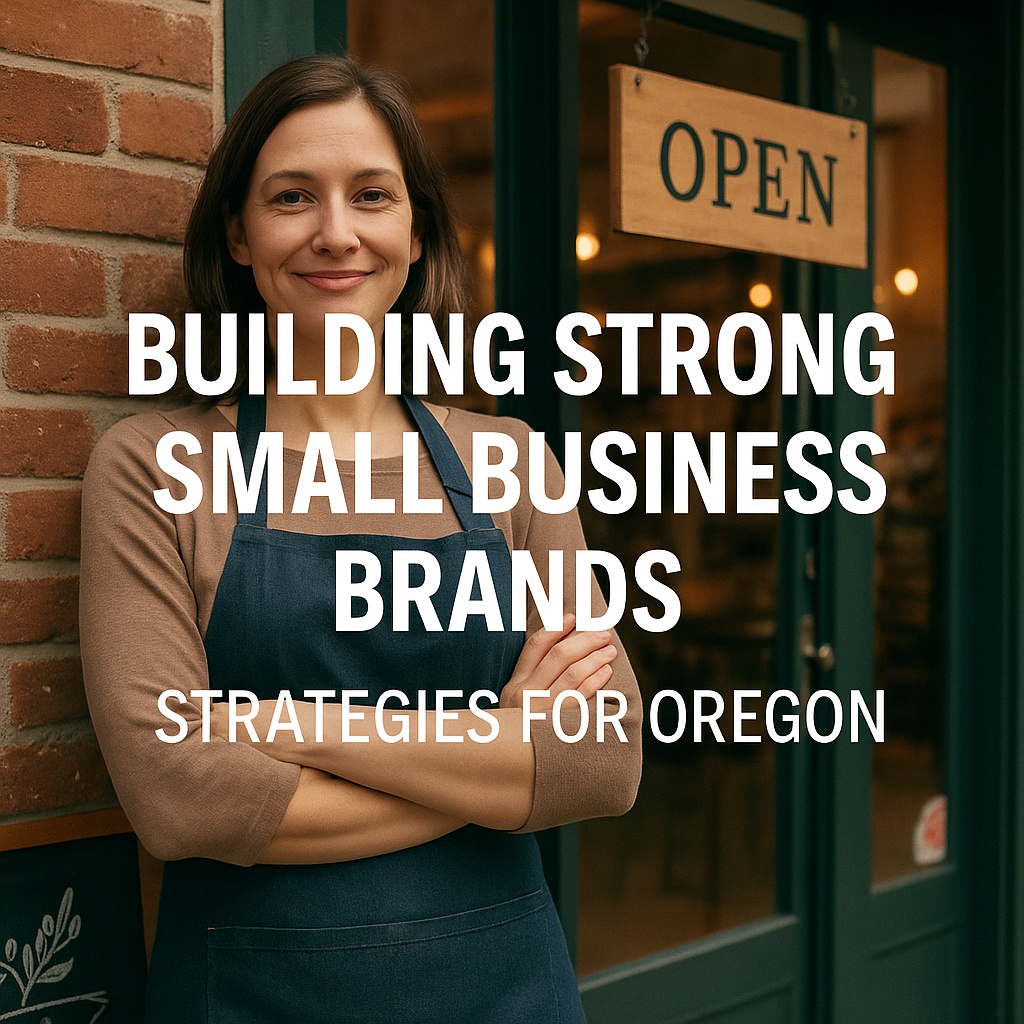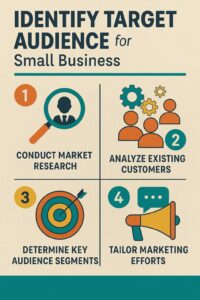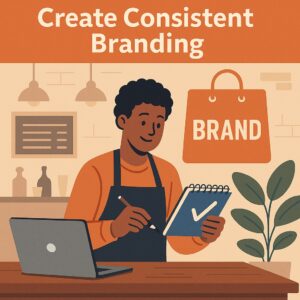If you’re running a business in Oregon, chances are you’re wearing a lot of hats. Whether it’s packing orders, managing your storefront, or handling marketing after hours, being a small business owner means getting close to the work. That closeness is exactly what makes small business brands different—and more powerful—when done right.
What Is a Small Business Brand?
A small business brand isn’t just a logo or color palette. It’s the way your business feels to your customers across every interaction. It’s the trust they build with your store and the reason they come back. For small businesses, brand isn’t some abstract concept. It’s personal. It’s hands-on. And it’s often the single most valuable asset you own.
In Oregon, the landscape of small businesses is wide and varied. You’ve got brick-and-mortar retail shops in small towns and online sellers running product lines from their homes. You’ve got service providers, family-owned shops, and new brands launching from co-ops or farmers markets. Despite how different they can look, one thing unites them: they operate at a scale where personal reputation matters and direct customer connection drives growth.
Helpful read: For a deeper dive on brand trust, see smart branding tips for small businesses.
A Look at the Diversity
Small enterprises and solo ventures often rely heavily on making a lasting impression quickly. Whether it’s a handmade goods store or an indie bookstore, local customers expect consistency, friendliness, and relevance to their values.
Online sellers operating through platforms like Etsy, Amazon, or their own storefronts juggle product visibility, shipping reliability, and customer trust. For these folks, brand shows up in product presentation, reviews, and even packaging details.
Retail shops selling physical goods use their brand to draw foot traffic, stand out in crowded markets, and give people a reason to choose them over bigger chains. Everything from the storefront sign to how staff greet customers feeds into this identity.
Organizations and micro-firms that offer services (like wellness practitioners, food vendors, or repair techs) build brand through relationships. That means every client interaction, response time, and tone of voice reflects your brand—whether intentional or not.
Related: Oregon-focused tips: Small business marketing tips for Oregon entrepreneurs.
Why This Matters
No one is buying from you just because you’re local. They’re buying because they trust you, they like what you stand for, and they get a consistent experience. That trust? That consistency? That’s branding.
So before diving into tactics and tools, get clear on what kind of small business you are. Not just by structure or product type, but by how you want people to feel about your business. That’s your starting point. From there, you can build a brand that actually drives sales—not just awareness.
Building a Strong Brand Identity for Small Businesses
Every business has a voice. The question is whether you’re shaping it intentionally or letting it happen by default. For small businesses in Oregon, where community and connection run deep, your brand identity isn’t just about how things look—it’s about what you stand for, how you communicate, and why people should care.
Pro tip: If you’re exploring help, here’s how to find the best branding agency for small businesses.
Start with Clarity: Mission, Voice, Visuals
Your mission isn’t a slogan. It’s a filter for decisions. It should be sharp, specific, and easy to explain without a script. Ask yourself: What are you really here to do? Who are you doing it for? How does that show up every day in your shop, in your product listings, or when someone emails you with a question?
Your voice is how that mission sounds. Whether your business has a warm, neighborly tone or a bold, confident edge, keep it consistent—on signs, on your website, in social captions, everywhere. Customers notice when tone slips. Stay honest, stay real, and talk like a human, not a brand book.
Your visuals are how it all looks. Logo and color choices matter, but so does photography, signage design, and even product packaging. Your visuals should match your values. If you’re a handmade soap business focused on clean ingredients and simplicity, don’t clutter your labels or signs with overly slick design. Keep it aligned.
Oregon package option: Peek at essential branding packages for Oregon small businesses.
Authentic Messaging That Connects
You don’t need viral campaigns. You need real resonance. That means messaging rooted in what your customers care about. Local references. Shared values. Specific benefits. Write like you’re talking to someone who knows your town, your challenges, and your heart for the business.
Keep it consistent, not canned. One strong message delivered the same way across your website, checkout page, local flyers, and social posts builds trust. People remember you when the experience feels whole. That’s where small brands can shine brighter than anyone with a marketing department.
Reference guide: Branding tips to enhance growth in 2025.
Differentiating with Purpose and Community
Big businesses compete on budget. You compete on identity and heart. If you’re clear on your purpose—and if you live it—customers will notice. Especially in Oregon, where community support means more than a punch card or discount code.
- Host events tied to your values (even small ones).
- Collaborate with other local businesses to show what you stand for.
- Respond to feedback like you’re talking to a neighbor—not a complaint form.
Branding isn’t something you fix in one shot. It’s a series of choices that stack up every day. Dial in how you present your mission, sharpen your voice, and stay consistent. That’s how you build a brand worth remembering—and defending.
Also see: Branding for small businesses: capture Oregon’s market.
Effective Online Presence Strategies for Small Business Brands
You can have the best mission and sharpest visuals, but if people can’t find you online—or if what they find looks outdated—you’re leaving money on the table. An effective online presence brings your offline experience into the digital world, and it starts with the basics.
Foundations: Why your business needs a strong online presence.
Get Your Website Doing Real Work
Your website should act like a trusted employee. It should answer questions, pull people in, and make buying (or booking) easy. At minimum, it needs to be fast, mobile-friendly, and clear. And yes, that means ditching the clutter.
- Homepage: Make your message obvious in the first few seconds. What you do, who it’s for, and what to do next should be unmistakable.
- Navigation: Simple beats clever. If people aren’t clicking, they’re leaving.
- SEO: Use plain-language headings, real keywords people might actually type in (especially Oregon-specific phrases), and descriptive alt text for images.
Your site is your home base. Every social profile, ad, and even packaging should pull people back to it. Treat it like part of your sales team.
More help: Top-5 web design trends for Hillsboro businesses.
Table: Quick Website Audit (15-Min Review)
| Area | What to Check | Fast Fix |
|---|---|---|
| Speed | Loads in <3s on mobile | Compress images; lazy-load |
| Clarity | Above-the-fold: what/for whom/CTA | Add a clear button |
| Trust | Reviews, badges, contact info | Add testimonials |
| SEO | Title tags, H1s, alt text | Use local keywords |
| Accessibility | Contrast, font size, focus states | Improve readability |
Need a partner? Web design that drives results in Hillsboro.
Be Smart About Social Media
Not every platform is worth your time. Choose two max—ones your audience actually uses—and show up consistently. Think of content as conversation, not broadcast.
- Post like a person, not a flyer. Behind-the-scenes, product usage, real talk, and local shoutouts all work better than tired promos.
- Use captions to connect. Show your values, local pride, or sense of humor. Generic posts get skipped.
- Engage. Comments aren’t just chatter. Every response builds trust or kills it. Make them count.
If you don’t have hours to spend, that’s fine. Batch a few posts at a time and use scheduling tools. Better to post less often and stay real than spam your feed with lifeless updates.
Starter kit: Mastering social media management and Top services offered by social media companies.
Local SEO: Your Digital Footprint in Oregon
If someone searches for your service + town and you don’t show up, you’re invisible. Local SEO helps people nearby find you right when they’re looking to buy.
- Claim and update your Google Business Profile. Fill it out completely. Add photos, hours, contact info, and respond to every review.
- Use targeted keywords. Phrases like “custom furniture in [city], Oregon” or “organic bakery near [neighborhood]” help you lock in local traffic.
- List on directories. Make sure your name, address, and phone number (NAP) are consistent across Yelp, Bing Places, and industry-specific directories.
Don’t skip the details. These touchpoints—your site, social posts, maps listing—are often the first impression people get. Every one of them should reflect the same trust, tone, and intention you show in person. Dial in your online presence not just for clicks but for connection. Customers want to find you, learn from you, and feel like they know you before they ever walk through the door—or click “add to cart.”
Learn more: Local SEO services: maximize your online presence and Local SEO—your guide to success in Hillsboro.
External guide: Google’s Business Profile Help Center.
Table: Local SEO Must-Haves (Oregon SMBs)
| Item | Why It Matters | Action |
|---|---|---|
| GBP completeness | Maps visibility & calls | Add photos, categories |
| NAP consistency | Trust + rankings | Sync across directories |
| Reviews & replies | Social proof | Ask & respond weekly |
| Local pages | Relevance | “[Service] in [City], OR” pages |
| Schema basics | Rich results | Add Local Business schema |
Leveraging E-commerce Platforms and Marketplaces
If you’re selling products as a small business, you can’t afford to ignore online marketplaces. Platforms like Amazon aren’t just for corporate giants—they offer real opportunities for small businesses to get in front of buyers who are ready to spend. But the key is knowing how to navigate that world without getting lost in it.
E-commerce SEO: Professional SEO for e-commerce websites.
Position Your Brand on Amazon the Right Way
Amazon wants small businesses to win—but you have to play by their rules. Their Support Small initiatives and badges offer visibility boosts, but only if you set up your listings correctly. That starts with registering as a small business in your Amazon account and making sure your company profile is completed and current.
Take advantage of the Support Small Store and small business filters by actively opting in (Amazon doesn’t do this automatically). These are low-effort ways to stand out, especially during shopping events when buyers are specifically searching for small brands.
Strategy note: Maximize your e-commerce success with expert SEO strategies.
Optimize Your Listings Like a Pro
You can’t just list a product and expect it to move. Each listing is part of your brand’s reputation. Use listings to do more than describe—use them to sell.
- Titles: Lead with plain language. Use keywords buyers actually search for, not clever phrasing.
- Images: Your main photo should be clean, sharp, and free of distractions. Add lifestyle shots in your image gallery to show what real use looks like.
- Descriptions: Skip filler. Highlight useful features, benefits, and who the product is for. Break it into bullet points for readability.
- Variations: Make it easy for customers to choose size, color, or flavor without clicking all over the place.
Protect your margins and your brand by staying consistent. Don’t undercut yourself or confuse shoppers with mismatched images and sloppy grammar. Amazon buyers scan first and click second. Show up polished.
Beyond Amazon: Other Platform Plays
Amazon isn’t your only option. E-commerce platforms like Etsy, eBay, or your own site power by Shopify or Squarespace can round out your strategy. Each has its own strengths, but the rule stays the same—branding matters.
- Keep your product presentation uniform across platforms. This builds credibility and helps customers recognize you wherever they shop.
- Use platform-specific features. Etsy loves story and process. Amazon values speed and specs. Lean into what works on each site without changing your core message.
- Drive traffic back to your main shop. Whether that’s your website or a preferred platform, use inserts in packaging, email follow-ups, and branding elements to guide the repeat path.
You don’t need to be everywhere—just fully show up where you are. Amazon and other marketplaces can widen your reach, but only if you treat them as brand channels, not just sales portals.
Table: Marketplace Fit (At-a-Glance)
| Platform | Best For | Notes |
|---|---|---|
| Amazon | High-intent searchers | Compete on clarity & reviews |
| Etsy | Handmade & niche | Lean into story & process |
| Shopify | Owned brand site | Control data, design, margins |
Product Strategies and Retail Considerations for Small Enterprises
Choosing what to sell—and how to package, price, and present it—isn’t just a business task. It’s a direct reflection of your brand. For small businesses in Oregon navigating tight margins, local competition, and online noise, product strategy needs to be deliberate. This isn’t about chasing hot trends. It’s about knowing your customers and giving them something they’ll actually buy, love, and talk about.
Helpful: Smart branding tips for trust & growth.
Curate With Purpose
Big-box stores win on quantity. You win on focus. A tight, purposeful product line is easier to manage, better to market, and more appealing to loyal customers than a cluttered one. Ask yourself three things when building your product line:
- Does this align with my brand values? (Think quality, style, values.)
- Is this something my target customer is already looking for?
- Can I stand behind this beyond first impressions?
If the answer is no to any of those, cut it. A curated shop feels intentional, not thrown together.
Packaging Is a Sales Tool
You don’t need expensive materials to make an impact. But packaging design should answer two questions: is it instantly recognizable, and does it reinforce your brand story? Stickers with your logo, handwritten thank-yous, and clear product labeling all matter. Thoughtful packaging also pulls its weight in the marketing department—it gets shared, reviewed, and remembered.
Keep it functional, brand-aligned, and repeatable. Don’t waste time on custom touches you can’t scale. Build a packaging system you can maintain through busy seasons.
Price With Confidence
Pricing isn’t about guessing what people will pay. It’s a mix of cost, margin, perceived value, and market position. Here’s a quick-check framework:
- Know your base cost (materials, labor, fees)
- Decide on your target profit margin—don’t work for free
- Compare with similar products in your niche without racing to the bottom
- Factor in the brand experience you’re offering
Charging less to “stay competitive” only hurts your long-term sustainability. Price for the business you want to grow into, not just the next sale.
Further reading: Mastering pricing with marketing analytics.
Create a Shopping Experience, Not Just a Transaction
Whether you’re selling online or in a physical shop, the shopping experience should guide a buyer from curiosity to confidence to checkout without friction. It’s not just about layout. It’s about emotion. People should feel good about spending money with you.
- In-store: Use lighting, displays, and signage that reflect your brand style. Keep it clean, organized, and easy to navigate. Staff attitude often matters more than square footage.
- Online: Nail your product photos, write clear descriptions, streamline checkout, and send customer emails that actually sound like you.
Every detail tells part of your story. If your brand is about care, quality, or fun, buyers should feel that in every click, bag, or email. That’s what they remember when deciding to come back—or recommend you. You don’t need to do more. You need to do better. Build your product strategy around clarity, consistency, and brand alignment. That’s how small shops win, online and off.
Marketing Trends and Tools Tailored for Small Business Growth
Staying visible as a small brand isn’t about jumping on every shiny new tactic. It’s about being smart with tools that match your scale, your time, and your budget. In 2025, that means tapping into trends that can actually move the needle—without overwhelming you or requiring a full-time team.
Trend watch (Oregon): Digital marketing Oregon—trends & top agencies.
Use AI Where It Makes Sense
You don’t need to be a tech expert to get value from AI tools. Focus on strategic, low-effort wins. One easy entry point? Product page content. AI writing assistants can help you draft or polish product titles, bullet points, and short descriptions, so each listing feels refined and purposeful without eating up your entire afternoon.
But don’t treat it like a set-and-forget tool. Always add your voice. Edit for clarity. Tie it back to your brand language. The goal is to save time, not hand over control. Use AI to get out of neutral faster—and then make it sound like you.
Deep dive: The impact of AI on digital marketing and AI personalization for small businesses.
Lean into Personalized Marketing
The days of sending the same offer to every customer are over. Now, even small businesses can personalize emails, product recommendations, and follow-ups that actually feel tailored. Use tools that sort buyers by behavior (like past purchases or browsing habits) and trigger messages based on what matters to them.
- Send restock alerts to repeat buyers
- Offer first-time discounts that match items viewed
- Follow up with a “we thought you’d like this” style message post-purchase
Start simple. Even just segmenting your list into new customers and returning ones can make your marketing feel much more human—and get better results.
Collaborate with Micro-Influencers
Large influencer campaigns are out of reach for most small shops, but there’s a more practical route. Team up with local creators, niche Instagram pages, or loyal customers with small but engaged followings. Offer product trades, early access, or shared promos.
The sweet spot? Someone whose audience overlaps with your buyers—and who actually shows up online with consistency. Think of it as relationship-based marketing, not mass exposure.
Run Community-Driven Campaigns
Customers want more than products—they want connection. That’s where community-driven marketing comes in. Run a photo contest featuring your product. Highlight customer stories on your feed. Invite shoppers to contribute ideas for seasonal products. Low-cost, high-engagement.
These aren’t just feel-good plays. They generate content, drive sharing, and build emotional momentum that’s hard for bigger brands to fake. You don’t need a budget to create buzz—you need participation.
Here’s the bottom line. Small businesses grow when they choose the right things to do, not everything. A few well-selected tools, platforms, and campaigns—run with your real voice and sharp instincts—can stretch further than an overloaded content calendar ever will.
Oregon focus: Online marketing Oregon—tools & tactics that work.
Sustaining Long-Term Growth by Nurturing Customer Relationships and Brand Loyalty
Repeat customers aren’t just convenient—they’re the foundation of real growth. When you run a small business in Oregon, especially one where people know your face and talk to your team directly, every experience counts double. You’re not chasing transactions. You’re building relationships that stack up over time and pay off in loyalty, word of mouth, and sustained revenue.
Customer-first mindset: Essential digital marketing for small businesses.
Service Is Your Brand in Motion
You can’t outsource good service. It’s in the replies you send, the packaging you prep, and how you treat customers when they walk in or reach out. Genuine attention builds trust. When someone buys from your brand and gets a fast, kind, helpful response, they remember. When they don’t, they leave—and don’t come back.
- Respond fast. Whether it’s an Instagram message or a product issue, speed shows respect.
- Be human. Avoid cold, copy-paste responses. Use names, show empathy, and sound like yourself.
- Follow through. If you say it’ll be fixed or sent out, do it. Quiet consistency speaks louder than big gestures.
Service doesn’t end at the sale. How you treat people after they buy shapes how long they stay.
Loyalty Programs That Actually Feel Good
If your loyalty program feels like an afterthought, it won’t work. Reward people in ways that make sense for your brand and their experience. Think beyond points systems and coupons. Focus on perks that feel personal or surprising.
- Offer exclusive early access to new products
- Send surprise thank-yous for milestone purchases
- Make your best customers feel known—not just tracked
People remember how you make them feel. Make loyalty feel like appreciation, not obligation.
Keep Evolving with Your Customers
Customer needs shift. Markets shift. If your brand doesn’t evolve, it gets stale. Keep a feedback loop going—ask, listen, and adjust. If something gets mentioned more than once (whether a missing product feature, a confusing checkout, or a packaging tweak), fix it. Let them see you adapt.
- Run simple polls in your email list or stories
- Invite suggestions with every order confirmation or thank-you note
- Test small changes and watch response before going all in
A responsive brand is harder to shake. When people know you’re listening, they stick with you—even when something better, cheaper, or newer shows up.
Consistency Beats Loud Marketing
You don’t need to be everywhere. You need to be reliable. Show up with the same tone, care, and quality across every channel, product, and conversation. That’s how trust becomes loyalty. Not with a flashy campaign, but through delivering what you say you will, again and again.
Don’t try to fake scale. Just be consistent. That’s what small businesses have that big players can’t fake—real, local relationships backed by repeatable excellence.
Focus on depth over width. It’s the long game that keeps your brand alive, not just visible. Nurture those relationships with focus and care. That’s how steady growth becomes long-term success.
Next steps: Essential branding package for small businesses in Oregon and Top branding company for small businesses in Oregon.
External resource: Oregon Small Business Development Center Network.
Key Takeaways
Quick hits for small business brands in Oregon
- Clarity wins: mission, voice, visuals—make them match.
- Your website is a sales rep. Keep it fast, clear, mobile-first.
- Local SEO = foot traffic and calls. Keep NAP consistent and reviews fresh.
- Treat marketplaces as brand channels, not just sales portals.
- Service and follow-through turn buyers into regulars.
FAQ
Q1: How many social platforms should I use?
Two is plenty. Show up consistently where your buyers already spend time.
Q2: What’s the fastest Local SEO win?
Fully complete your Google Business Profile and start asking for reviews weekly.
Q3: Do I need to sell on Amazon?
Not always. If your buyers search there, yes—just keep brand standards tight and listings polished.
Q4: How often should I update my website?
Review monthly. Fix speed, refresh hero copy, and update FAQs/products as needed.
Additional Resources
- Oregon small business branding package for growth
- Online marketing guide for small businesses in Oregon
- Social media marketing strategies for Oregon businesses
Want help tightening up your brand, website, or Local SEO? Talk with Nesace Media—we’ll map a plan that fits your time and budget.







